This article was co-authored by Alex Dimitriu, MD. Alex Dimitriu, MD is the Owner of Menlo Park Psychiatry and Sleep Medicine, a clinic based in the San Francisco Bay Area with expertise in psychiatry, sleep, and transformational therapy. Alex earned his Doctor of Medicine from Stony Brook University in 2005 and graduated from the Stanford University School of Medicine's Sleep Medicine Residency Program in 2010. Professionally, Alex has dual board certification in psychiatry and sleep medicine.
There are 15 references cited in this article, which can be found at the bottom of the page.
This article has been viewed 138,260 times.
For many people, rotator cuff pain can be worse at night when they are trying to sleep. Your rotator cuff includes the muscles and tendons that help your arm stay in its sockets and move around. If your sleep is suffering because of this, try changing the position you sleep in. Use ice, heat, or painkillers to ease your pain and discomfort.[1] If sleep is still difficult, try adjusting your sleep schedule or mattress.
Steps
Trying Different Sleep Positions
-
1Sleep sitting up when you are first injured. For the first 2 days after your injury, you should sleep with your back upright. Try sleeping in a reclining chair or propping yourself up on pillows in bed. Lie back in a reclined position with your shoulders propped up and supported.[2]
- If you have an adjustable reclining bed, move the headrest up to a reclining position to sleep.
-
2Stick a pillow between your legs if you sleep on your side. Sleep on your unaffected shoulder, not on your injured shoulder. The pillow between your legs will help keep your body aligned properly as you sleep. You might also hug a pillow in your arms.[3]Advertisement
-
3Prop a pillow under the arm on the affected side when on your back. Put the pillow under your arm to raise the arm and alleviate some of the pressure on your rotator cuff. This can help ease your rotator cuff pain as you sleep.[4]
- You can use a regular pillow.
-
4Avoid sleeping on the affected side or on your stomach.[5] These positions may cause more discomfort. Even if these are your normal sleep positions, try starting out in a different position.
Reducing Shoulder Pain at Night
-
1Ice your shoulder for 15-20 minutes before bed.[6] Wrap an ice pack in a towel and rest your shoulder against it while sitting or lying down. You can also use an ice compression wrap that slings around your shoulder. This can reduce pain and inflammation.[7]
- Do not sleep with an ice pack. Remove the ice pack before you go to bed.
- Ice compression wraps can be purchased at sports stores and pharmacies. Follow the instructions on the box for chilling and applying the wrap.
- It is better to ice your shoulder within the first 2 days after your minor injury. After that, you can use heat.
-
2Apply heat to your shoulder after 48 hours. Heat has many of the same benefits as icing your shoulder, such as relieving pain and reducing inflammation. Don't use heat for at least 48 hours after your injury, or it could make your shoulder stiff. Before you go to bed, put heat on your shoulders for 15-20 minutes. You can:[8]
- Wrap a heating pad around your shoulder.
- Fill a water bottle with hot water. Wrap the bottle in a towel and rest your shoulder against the bottle in a chair.
- Take a hot shower.
- Soak a towel in warm water and wrap it around your bare shoulder. Make sure that the water is warm and not scalding hot.
-
3Do low-impact exercises during the day. The right exercises can reduce pain and improve your sleep. That said, some exercises may worsen your rotator cuff injury. Talk to your doctor or physical therapist to determine the best exercises for you.[9]
- Stretches like crossover arm stretches or pendulums may be able to reduce pain and restore flexibility.[10]
- Low-impact exercises like walking or swimming can help you stay limber and active. Aim for 30 minutes of exercise in the afternoon so that you feel tired later that evening.
- Avoid exercises that involve lifting heavy objects, holding yourself up with your arms, or raising your arms above your head.[11]
-
4Limit movement at night to rest your shoulder. While some exercise can help reduce pain, you do not want to overdo it, especially at night. Instead, give your shoulder a break at night. Avoid heavy exercise, stretches, lifting objects, or activities where you have to lift your arm over your shoulders.[12]
- If your physical therapist or doctor has advised specific exercises before bedtime, follow their instructions.
-
5Take an over-the-counter painkiller before bed. Acetaminophen (like Tylenol), ibuprofen (like Motrin or Advil), or naproxen (Aleve) can help reduce pain before you sleep. About 20 minutes before you go to bed, take 1 dose according to the instructions on the label.[13]
Improving Your Quality of Sleep
-
1Keep a consistent sleep schedule to help you fall asleep on time. According to sleep medicine and psychiatry professional Alex Dimitriu, "If you go to bed and wake up at the same time every day, it will be easier for you to fall asleep." While you heal, go to bed at the same time every night.[14]
-
2Wear an arm sling when you go to bed. Purchase arm slings or bandages at pharmacies and grocery stores. Wrap your shoulder before you go to bed according to the instructions on the box. This will keep your shoulder from moving too much while you sleep.[17]
- If your doctor recommends wearing a sling at night, they may give you a sling to wear.
-
3Invest in a new mattress for chronic rotator cuff pain. Most rotator cuff injuries heal in 4-6 weeks. If your pain returns, however, you may need a new mattress. Look for a mattress with medium firmness. It should be firm enough to support your joints but not so firm that it causes back pain.[18]
- Try lying down on the mattress before you buy it. If you sink into the mattress, it may be too soft to support your shoulder. If the mattress puts pressure on your back or feels uncomfortable, it may be too firm.
- If your mattress is causing you pain, try sleeping on the floor. Some people find it easier to fall asleep on a firm surface.[19]
-
4Take an over-the-counter sleep aid only if necessary. Common sleep aids include diphenhydramine (such as Benadryl) or doxylamine succinate (like Unisom SleepTabs). Only take sleep aids if the pain is severe or if you cannot fall asleep after a long time. Read the instructions before taking these medications.[20]
- Never take sleep aids for longer than 2 weeks at a time. You can grow to be dependent on these medications.
- Talk to your doctor before you take a sleep aid, especially if you are taking other medications. Your doctor can tell you if the medication will cause a bad reaction with any of your current medications.
- Do not drink alcohol as a sleep aid, especially if you are taking medication. Alcohol can make you feel sleepy, but it will not improve your quality of sleep. If mixed with sleep aids, it can be extremely dangerous.
- Try to limit naps during the day. Keep your naps under 30-45 minutes to make it easier to fall asleep at night.[21]
-
5Talk to your doctor if your quality of sleep is consistently disturbed. If you still can't sleep at night or if your work and social relationships are suffering, visit a doctor. Tell the doctor about your pain. Mention that you can't sleep properly. Your doctor may recommend a number of treatment options.[22]
- Your doctor may prescribe a stronger painkiller for your shoulder or give you medicine to help you sleep.
- Your doctor can give you injections to reduce shoulder pain temporarily. These injections will wear off over time, but they can help you sleep better.
- Your doctor can refer you to a physical therapist who can guide you through safe exercises. These exercises may reduce pain and restore your shoulder function.
- In severe cases, your doctor may recommend surgery to remove bone spurs, repair the tendon, or replace the shoulder.
Expert Q&A
Did you know you can get premium answers for this article?
Unlock premium answers by supporting wikiHow
-
QuestionHow should you sleep if your shoulder hurts?
 Alex Dimitriu, MDAlex Dimitriu, MD is the Owner of Menlo Park Psychiatry and Sleep Medicine, a clinic based in the San Francisco Bay Area with expertise in psychiatry, sleep, and transformational therapy. Alex earned his Doctor of Medicine from Stony Brook University in 2005 and graduated from the Stanford University School of Medicine's Sleep Medicine Residency Program in 2010. Professionally, Alex has dual board certification in psychiatry and sleep medicine.
Alex Dimitriu, MDAlex Dimitriu, MD is the Owner of Menlo Park Psychiatry and Sleep Medicine, a clinic based in the San Francisco Bay Area with expertise in psychiatry, sleep, and transformational therapy. Alex earned his Doctor of Medicine from Stony Brook University in 2005 and graduated from the Stanford University School of Medicine's Sleep Medicine Residency Program in 2010. Professionally, Alex has dual board certification in psychiatry and sleep medicine.
Sleep Medicine & Psychiatry Professional
References
- ↑ https://www.health.harvard.edu/pain/what-to-do-about-rotator-cuff-tendinitis
- ↑ https://www.sports-health.com/blog/sleeping-rotator-cuff-pain
- ↑ https://health.clevelandclinic.org/2015/01/how-to-keep-sore-hips-knees-shoulders-from-ruining-your-sleep/
- ↑ https://www.sports-health.com/blog/sleeping-rotator-cuff-pain
- ↑ https://medlineplus.gov/ency/article/000438.htm
- ↑ https://my.clevelandclinic.org/health/diseases/7079-shoulder-impingement-syndrome
- ↑ https://www.mayoclinic.org/diseases-conditions/rotator-cuff-injury/diagnosis-treatment/drc-20350231
- ↑ https://www.hopkinsmedicine.org/health/treatment-tests-and-therapies/ice-packs-vs-warm-compresses-for-pain
- ↑ https://health.clevelandclinic.org/2015/01/how-to-keep-sore-hips-knees-shoulders-from-ruining-your-sleep/
- ↑ https://orthoinfo.aaos.org/en/recovery/rotator-cuff-and-shoulder-conditioning-program/
- ↑ https://myhealth.alberta.ca/Health/aftercareinformation/pages/conditions.aspx?hwid=ug3498
- ↑ https://www.health.harvard.edu/pain/what-to-do-about-rotator-cuff-tendinitis
- ↑ https://medlineplus.gov/ency/article/000438.htm
- ↑ https://health.clevelandclinic.org/2015/01/how-to-keep-sore-hips-knees-shoulders-from-ruining-your-sleep/
- ↑ Alex Dimitriu, MD. Sleep Medicine & Psychiatry Professional. Expert Interview. 16 October 2019.
- ↑ https://www.helpguide.org/articles/sleep/sleep-needs-get-the-sleep-you-need.htm
- ↑ https://myhealth.alberta.ca/Health/aftercareinformation/pages/conditions.aspx?hwid=ug3498
- ↑ https://health.clevelandclinic.org/2015/01/how-to-keep-sore-hips-knees-shoulders-from-ruining-your-sleep/
- ↑ Alex Dimitriu, MD. Sleep Medicine & Psychiatry Professional. Expert Interview. 16 October 2019.
- ↑ https://www.mayoclinic.org/healthy-lifestyle/adult-health/in-depth/sleep-aids/art-20047860
- ↑ Alex Dimitriu, MD. Sleep Medicine & Psychiatry Professional. Expert Interview. 16 October 2019.
- ↑ https://www.mayoclinic.org/diseases-conditions/rotator-cuff-injury/diagnosis-treatment/drc-20350231
About This Article
It can be hard to sleep with rotator cuff pain, but by applying a cold or hot compress, using a sling, and changing your sleeping position, you’ll get a better night’s rest. For the first 48 hours, apply an ice pack or bag of frozen vegetables wrapped in a towel to your shoulder for 15-20 minutes before bed. This will help numb the pain and reduce inflammation. After 48 hours, use a heating pad or hot water bottle instead. When you go to bed, take an extra pillow or 2 with you. If you normally sleep on your side, put a pillow between your legs to keep your body aligned. If you normally sleep on your back, put an extra pillow under your arm to raise your injured shoulder and take pressure off your rotator cuff. Keep your arm in a sling to prevent it from moving around and causing you pain. For more tips from our Medical co-author, including how to do some light exercise to help reduce your rotator cuff pain, read on!

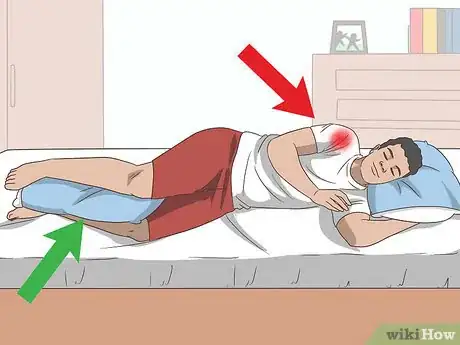
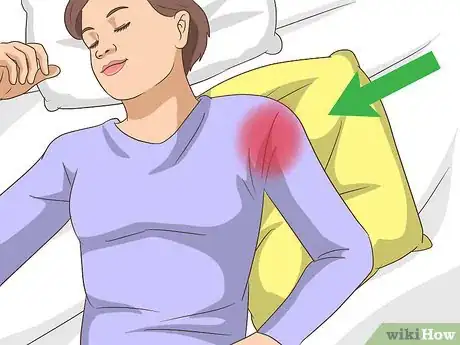
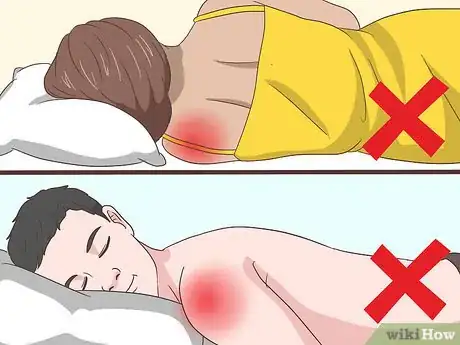
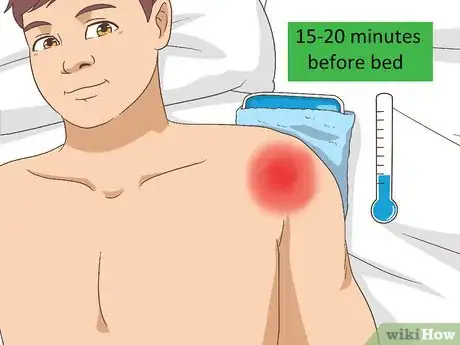


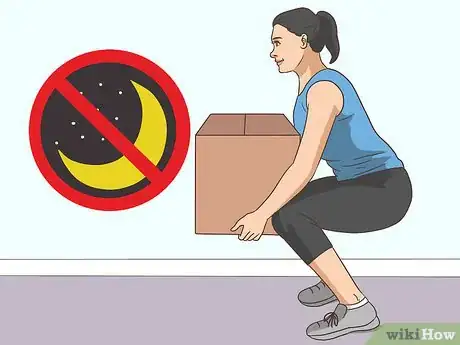



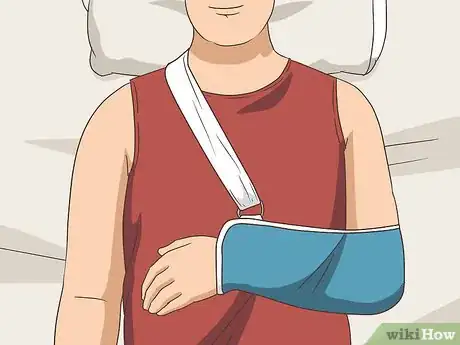
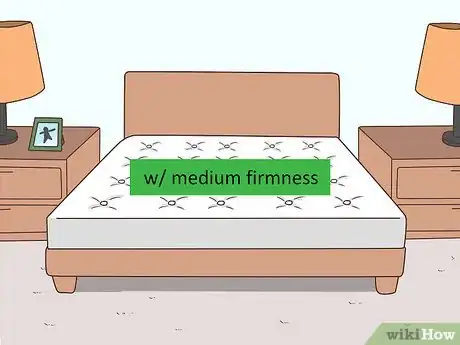

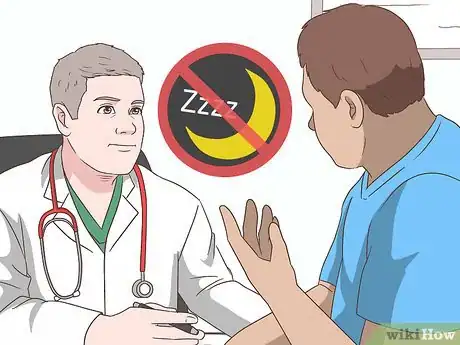








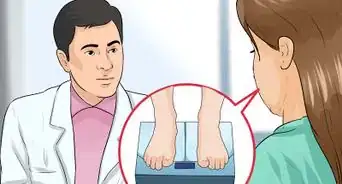

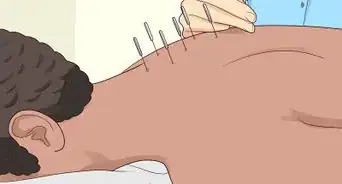
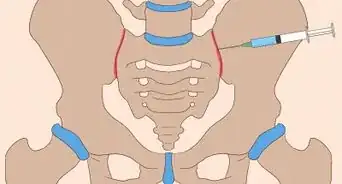
















































Medical Disclaimer
The content of this article is not intended to be a substitute for professional medical advice, examination, diagnosis, or treatment. You should always contact your doctor or other qualified healthcare professional before starting, changing, or stopping any kind of health treatment.
Read More...